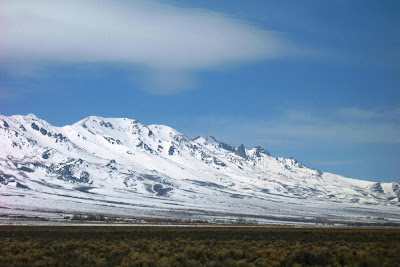


We took a mini road trip the other day, and drove by the east side of the Ruby Mountains (first photo above) and the east side of the East Humboldt Range (second two photos above), which are both south of Wells. Nevada. The East Humboldt Range appears to be partly a topographic or structural continuation of the Ruby Mountains (MSRMaps), possibly with some complications from Basin-and-Range faulting. The Ruby Mountains (and East Humboldt Range?) are part of a metamorphic core complex, like the core complex in the northern Snake Range, part of which can be seen in the header photo at the top of this blog. Both core complexes are the result of more or less east-west extreme extension, which took place during the early to middle Tertiary, prior to classic Basin-and-Range extension.
A core complex is a doubly plunging antiform, with one axis parallel to the extension direction. A core complex exposes rocks that were ductilely deformed at depth against rocks that were brittlely deformed closer to the surface. These rocks come into contact along a detachment fault or decollement. The core complex belt in the North American Cordillera runs from British Columbia south into Mexico. [That last link also shows a cartoon of a core complex with upper plate rocks dipping in opposite directions, which is either inaccurate or misleading). There are several models for their formation, and they may form differently in places outside the belt, like in the Walker Lane.
If you look at a core complex perpendicular to the extension direction, you can usually see that the antiform is not perfectly symmetrical. For example, if you stand on Highway 50 east of Sacramento Pass, where it passes between the northern Snake Range to the north and Wheeler Peak to the south (part of Great Basin National Monument), you will see the core complex and detachment fault looking somewhat like the banner photo above. That photo was taken from the road to Wheeler Peak, looking north. What you'll notice, either from Highway 50 or from Wheeler Peak, is that the northern Snake Range core complex has a fairly steep western side (not seen in the banner photo) and a more subdued eastern side. The detachment fault associated with a particular core complex will also follow this pattern of dipping more steeply on one side and more gently on the other side.
In the Snake Range, the blocks of brittlely deformed upper-plate strata (Paleozoic in general) dip to the west on listric-normal faults that dip eastward and merge downward into the detachment fault. Because down-to-the-east motion on these normal faults can be inferred (and demonstrated), one can then tell that the upper plate moved eastward relative to the lower plate.
Above, we have some photos of the steep east sides of the Ruby Mountains and East Humboldt Range. The steepness of this eastern side may have been influenced by Basin-and-Range faults that formed after the original geometry of the Ruby Mountains core complex (Basin-and-Range faults that are presumably active today, judging by some of the recent earthquake damage in Wells - albeit on a fault farther to the east).
Now, if you drive west from Wells toward Elko on Interstate I-80 and look south, you'll see the Ruby Mountains western aspect, below. This western side confirms the typical core-complex asymmetry, with the overall appearance of the mountains being steep on the east side and gently westward dipping on the west side.
 Because of what we've already seen with the northern Snake Range core complex, we can figure out just by looking at the shape of this western side (above) that the brittlely deformed rocks in the upper plate of the Ruby Mountains core complex dip to the east on westward dipping listric-normal faults, and that the relative motion on the detachment fault is upper plate moving to the west with respect to the lower plate - and that's all opposite to dip directions and relative motion in the Snake Range. You can confirm the relative sense of motion in the Ruby Mountains core complex here.
Because of what we've already seen with the northern Snake Range core complex, we can figure out just by looking at the shape of this western side (above) that the brittlely deformed rocks in the upper plate of the Ruby Mountains core complex dip to the east on westward dipping listric-normal faults, and that the relative motion on the detachment fault is upper plate moving to the west with respect to the lower plate - and that's all opposite to dip directions and relative motion in the Snake Range. You can confirm the relative sense of motion in the Ruby Mountains core complex here.Overall Reference for Core Complexes:
Coney, P.J., 1980, Cordilleran metamorphic core complexes—An overview, in Crittenden, M.D., Jr., Coney, P.J., and Davis, G.H., eds., Cordilleran metamorphic corecomplexes: Geological Society of America Memoir 153, p. 7–34.
Updated 30Jul2010: Wherein I added mentions of the East Humboldt Range and linked to a map location.
No comments:
Post a Comment